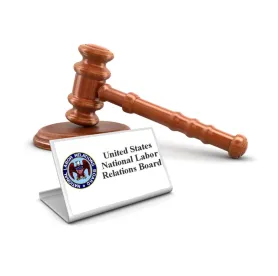The NLRB has reversed decades of precedent and made it far easier for unions to represent employees, including manufacturers, without a secret ballot election. The NLRB’s new standard (announced in Cemex Construction Materials Pacific, LLC, 372 NLRB No. 130 (2023)) emphasizes union authorization cards that are gathered by union officials and union activists who often employ high-pressure tactics to obtain a signature. Employees often sign authorization cards without the benefit of understanding the significance of the cards. Even if they don’t want a union, they may sign because they feel pressured by a coworker, don’t want to offend a colleague, or want to avoid being bothered. The new standard still permits an election, but the NLRB will only conduct an election if the employer petitions for an election promptly, usually within two weeks of the union’s demand for recognition. Even if an employer petitions for an election, the NLRB will set aside that election if the employer commits virtually any misstep during the period leading up to the election. Thus, if the union loses the election and the Employer commits an unfair labor practice, the NLRB will look to union cards and likely order that the employer recognize and bargain with the union. The impact of this new standard is that any union that gathers authorization cards from a majority of employees in an appropriate bargaining unit has a relatively easy path to recognition without an election and despite an election loss.
The New Process – Union Demand for Recognition & Employer Response
Under the NLRB’s new standard, once a labor union gathers authorization cards from a majority of employees, it must simply request that the employer recognize it as the representative of employees in an appropriate bargaining unit. The NLRB did not address what makes a request for recognition sufficient (e.g. verbal vs. written) or to whom the union must make this request. Once a union makes this request, an employer must file a petition for an election, “usually within two weeks.” If it fails to do so, the employer essentially waives its employees’ ability to vote on unionization in a secret ballot election.
If the employer does nothing, a union seeking representation may either file a representation petition (consistent with prior precedent) or file an unfair labor practice (ULP) claiming a refusal to bargain. If, during that ULP proceeding, the union establishes that it has union authorization cards from a majority of employees in an appropriate bargaining unit, the Board will order the employer to recognize the union, without an election. In that situation, the obligation to bargain will be retroactive to the union’s demand for recognition, so any changes that an employer makes to working conditions after the demand for recognition would be a separate violation of the NLRA.
If the employer timely files a petition for an election, the NLRB will process the petition according to its new expedited election rules (effective December 26, 2023), which likely means an election in about three weeks from the date that the employer files the petition. In another dramatic break from precedent, “if the employer commits an unfair labor practice that requires setting aside the election, the petition will be dismissed, and the employer will be subject to a remedial bargaining order.” Cemex Construction Materials Pacific, LLC, 372 NLRB at 26 (emphasis added).
The standard for ordering bargaining without an election is much broader that the narrow “Gissel” standard authorized by the US Supreme Court in 1969. Gissel Packing Co., 395 U.S. 575 (1969). Thus, if the employer commits “unfair labor practices that frustrate a free, fair, and timely election, the Board will dismiss the election petition and issue a bargaining order, based on employees’ prior, proper designation of a representative . . .,” i.e., whether the authorization cards establish majority support. Cemex Construction Materials Pacific, LLC, 372 NLRB at 28.
For a bargaining order, the question is whether “the employer rendered a current election (normally the preferred method for ascertaining employees’ representational preferences) less reliable than” authorization cards. While the Board provided certain examples of conduct that erode majority support evidenced by authorization cards (“nip-in-bud” discharges of union supporters; coercive statements; and unlawful granting or withholding of benefits made just before an election), the standard is broader. Thus, during the “critical period” between the petition and the election, the NLRB has set aside an election based on certain violations unless the “violations are so minimal or isolated that it is virtually impossible to conclude that the misconduct could have affected election results.” The new standard does not require a finding that every ULP is disruptive of the election process, but requires consideration of all relevant factors, including:
- number of violations;
- severity of violations;
- extent of dissemination;
- size of the bargaining unit;
- closeness of the election (if one has been held);
- proximity of the conduct to the election date; and
- number of unit employees affected.
Further, the NLRB acknowledged that it has found, under specific factual circumstances, that an employer’s maintenance and dissemination to all employees of certain generally applicable handbook rules and policies have required setting aside an election, which is especially important considering the Board’s new, much stricter standard (announced in Stericycle, Inc. 372 NLRB No. 131 (2023)) for evaluating handbook rules and policies.
Takeaway – The Focus is on Union Authorization Cards
With the emphasis that the NLRB’s new standard places on union authorization cards, it becomes more important for employees to understand their significance. If an employee does not understand the full legal weight of signing a card or what it means to have a union, employees who would otherwise reject a union may sign an authorization card to avoid offending their coworkers or because of group pressure. Also, while it’s improper for union organizers and adherents to coerce employees or misrepresent the nature and purpose of an authorization card, gathering that evidence and establishing it before a judge can be challenging.
It is important to know that manufacturers need not wait. Manufacturers are permitted to speak with their employees about unions and union authorization cards. The NLRB specifically recognized that an employer is free and legally permitted to persuade employees with lawful expressions of its views concerning unions.
It is also important to know that manufacturers that accept and examine union authorization cards or that otherwise gain independent knowledge of a union’s majority support are at risk of a bargaining order. Manufactures could have a union without employees ever hearing from their employer or having the opportunity to vote in a secret ballot election.
At this critical time, it’s important for manufacturers to gather internal stakeholders (e.g., HR, legal, compliance and senior management) to set priorities, identify risks and develop action items so that a plan is in place before the issue arises. Manufacturers may want to provide supervisor training so that supervisors understand the simple rules for communicating with employees about unions and ensure that workplace policies comply with the new NLRB standard for evaluating the lawfulness of common workplace policies. Manufacturers should also consider contacting competent legal counsel to identify, discuss, and mitigate any existing or potential risks.



 />i
/>i
